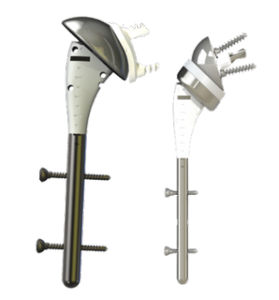

- Products
- Catalogs
- News & Trends
- Exhibitions
Reverse shoulder prosthesis ARAMIS-Rrevisioncementless
Add to favorites
Compare this product
fo_shop_gate_exact_title
Characteristics
- Shoulder prosthesis type
- reverse
- Surgical application
- revision
- Fixation
- cementless
Description
Thanks to its dedicated humeral stem, the ARAMIS-R prosthesis can effectively treat revisions of the upper end of the humerus, for loosening or fracture of a prosthesis, but also certain indications in tumour surgery. It is available in anatomical (hemiarthroplasty/total) or inverted versions and, thanks to its locking possibilities, allows the stem to be held in the humerus in an optimal manner. Coated with a bi-layer of osseointegratable titanium and hydroxyapatite, it can be locked by 2 screws.
The revision humeral stem is available in 5 diameters and 3 lengths, with a single angulation of 140°.
The Ø 7 stem is only available in 180 mm length and is not lockable.
Its instrumentation allows for easy insertion.
The ARAMIS-R revision prosthesis benefits from all the advantages of the ARAMIS range
Anatomical version: The adaptation of the humeral heads allows a precise anatomical restoration.
An inversed version: The cervico-diaphyseal angle has been fixed at 140°. This varisation leads to a beneficial increase in the lever arm of the deltoid by lateralization. Combined with an optimisation of the position of the glenoid piece, it significantly reduces the appearance of notches. The use of the Aramis standard range of glenoid bases allows optimal anchoring of the glenoid component in the scapula.
Ergonomic instrumentation: The ergonomic and compact instrumentation (only one ancillary box) allows precise adjustment of the implant positioning. It allows the use of either the delto-pectoral or the superolateral approach.
Related Searches
- Orthopedic surgery surgery set
- Arthrodesis screw
- Shoulder prosthesis
- Metallic arthrodesis screw
- Foot arthrodesis screw
- Cannulated arthrodesis screw
- Metallic osteotomy screw
- Osteotomy screw
- Digit joint implant
- Reverse shoulder prosthesis
- Revision shoulder prosthesis
- Cementless shoulder prosthesis
- Hand arthrodesis screw
- Cancellous osteotomy screw
- Forefoot arthrodesis screw
- Trapeziometacarpal joint implant
- Hallux valgus arthrodesis screw
- Locking osteotomy screw
*Prices are pre-tax. They exclude delivery charges and customs duties and do not include additional charges for installation or activation options. Prices are indicative only and may vary by country, with changes to the cost of raw materials and exchange rates.



